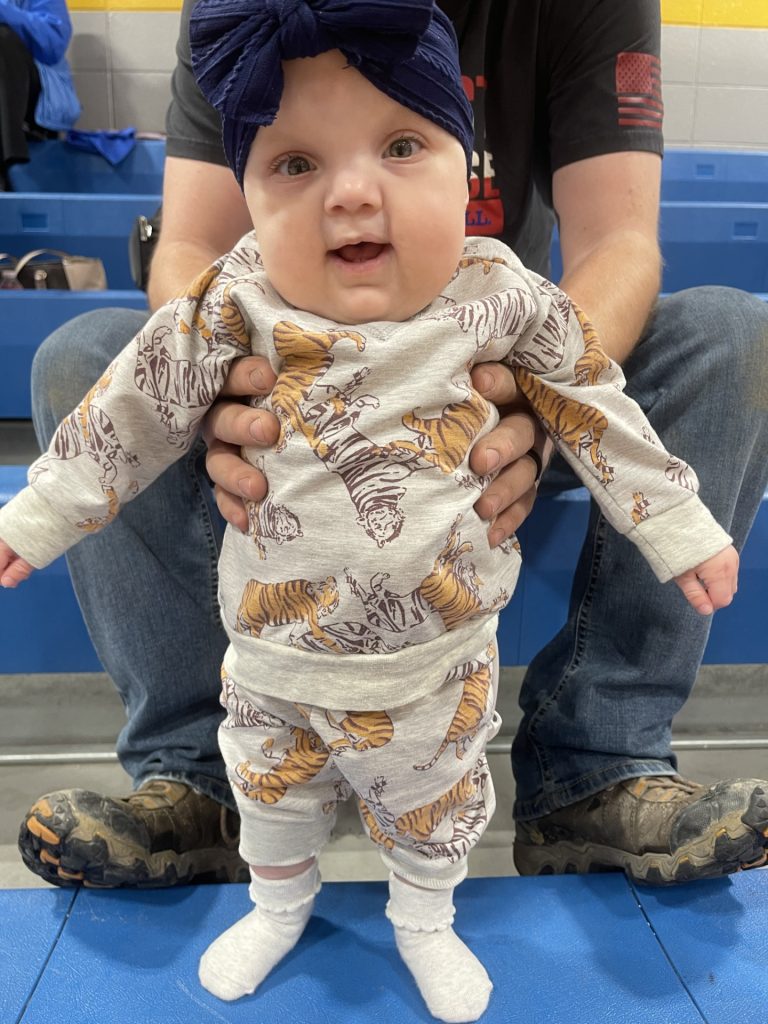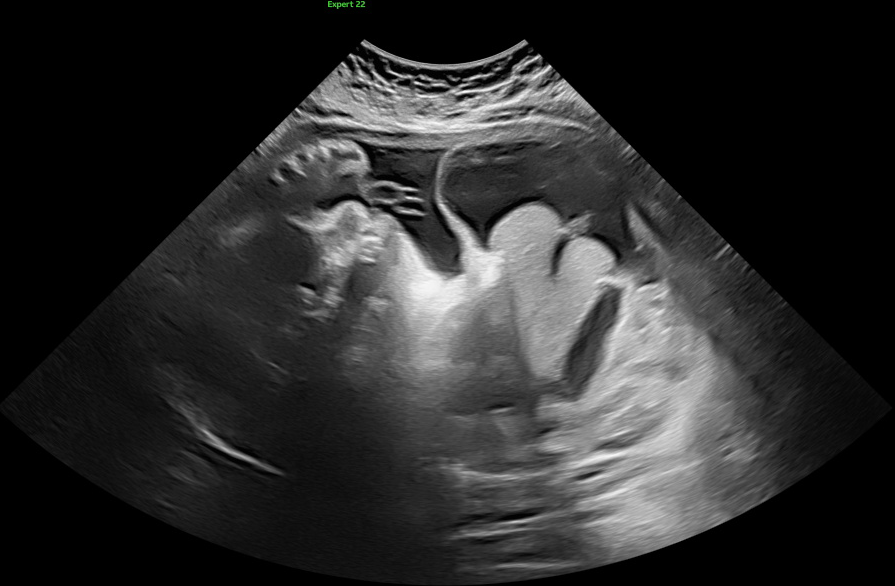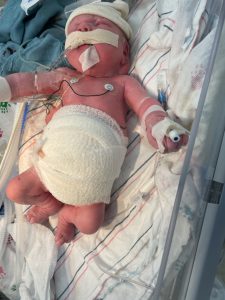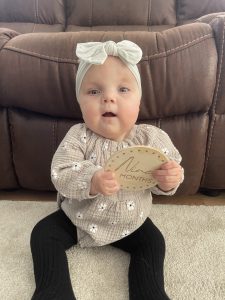Looking at precious photos of baby Hallie’s piercing eyes, adorable cheeks and smile; you probably would never imagine the difficult care journey she endured at such a young age. It all started before Hallie was born when her mom, Danielle, learned shocking news during a routine ultrasound appointment.
The first-time mom learned that her local care team in North Dakota suspected her unborn baby was hydropic, a potentially life-threatening condition that meant Hallie had a dangerous amount of fluid accumulating in her body around her neck, back and abdomen in-utero. “We were told that the outcome of my pregnancy may not be what we want,” Danielle shared.
Arriving at the Midwest Fetal Care Center
Danielle and Hallie’s care journey quickly took a new course of action when Dr. Michele Pasierb, a pediatric cardiologist with Sanford Health in North Dakota, referred her to the Midwest Fetal Care Center (MWFCC), a collaboration between Allina Health and Children’s Minnesota. Soon, Danielle and her husband, Hunter, made the first of what would be many ten-hour drives from their home in northwestern North Dakota to Minneapolis.

“Being so far away from home and being only 25 years old, it was a huge shock to us,” Danielle explained. “But we wanted to do everything we could to give our baby a chance to survive.”
Once the expecting parents arrived at the MWFCC, they met with a large team of multi-disciplinary fetal care specialists including Dr. Saul Snowise, medical director of the MWFCC; and Dr. Cliff Brock, maternal and fetal medicine specialist at the MWFCC. During their first ultrasound appointment with Dr. Brock, Danielle and Hunter received some positive news.
“Dr. Brock glanced at the screen and told us, ‘This isn’t a hydropic situation, your baby has an omphalocele,’” Danielle recalled.

Dr. Brock explained to Danielle how an omphalocele diagnosis meant her baby had a much higher chance of surviving. However, the birth defect did present its own potential complications. An omphalocele is an opening where the umbilical cord goes into the belly and leaves vital organs exposed within a membrane outside the baby’s body. Hallie’s case was severe. According to the Centers for Disease Control and Prevention (CDC), a membrane can contain an infant’s intestines, liver or other organs. Many babies born with an omphalocele also face other challenges such as heart defects, neural tube defects and chromosomal abnormalities the CDC explains.
“Since week 12 of my pregnancy, we were told that our baby may not have a heart beat the next week. Getting that news from Dr. Brock and his team that she [Hallie] had a much higher survival rate, it was kind of a relief that you cannot explain,” Danielle shared.
Danielle, now 32-weeks pregnant, inched closer to delivery day. Her MWFCC team closely monitored her and developed a personalized care plan ahead of Hallie’s arrival.
“We knew we were in the right place for our daughter, giving her the best chance to be with us today,” Danielle said.
Delivery day
On April 25, 2023, it was time for Hallie to enter the world at The Mother Baby Center, a partnership between Allina Health and Children’s Minnesota. Dr. Brock delivered Hallie via an enlarged cesarean section while ensuring the giant thin sac containing all the abdominal content and fluid was protected.
“Hallie’s omphalocele was one of the more high-risk abdominal wall defects that we see, requiring special care and expertise to ensure safe delivery of thinly covered organs,” said Dr. Brock. “There were times that we were concerned about Hallie’s survival before she was born, but we remained confident for a positive outcome because of our experience treating these types of cases that are often the most severe in the region.”
Within moments of her birth, the newborn was rushed from the delivery room to the neonatal intensive care unit (NICU) at Children’s Minnesota. Just three days later, Dr. Joe Lillegard and Dr. James Fisher, pediatric surgeons at Children’s Minnesota, performed a delicate procedure to place Hallie’s exposed vital organs in her abdomen and close it in just one surgery, rather than the more common two or three operations. When Hallie turned 5-days-old, her mom got to see her daughter’s eyes for the first time.
“Two days post-op and all she could do was just stare at us,” Danielle said. “Our hearts were filled with so much excitement. I couldn’t wrap my head around the fact that my daughter just went through a major surgery and the outcome was better than expected.”
An extended stay at Children’s Minnesota
Baby Hallie spent her first 84 days on earth in the Level IV NICU at Children’s Minnesota in Minneapolis. The unit has the highest designation by The American Academy of Pediatrics and provides patient families with the in-house expertise of the neonatology program at Children’s Minnesota, which cares for the most high-risk newborns. Hallie then spent another 40 days in the hospital’s infant care center, hundreds of miles from home.
“Being away from family almost broke me,” Danielle said. “But we had excellent nurses and doctors who filled that large void, and we forever will be grateful for them.”
When Danielle wasn’t by her daughter’s side, she participated in a NICU support group where she joined other moms going through a similar journey, “It really makes you open your eyes that you are truly not alone in this world. I’ve made some great friends through that group.”

Hallie heads home
After 124 days at Children’s Minnesota, baby Hallie finally got to go home to North Dakota.
“It didn’t feel real until we walked out of the hospital and to our car,” Danielle recalled. “Putting Hallie into the back seat and hearing the click of her car seat was a moment I’ll always remember. It was really happening for us; we finally knew how it felt to bring a baby home.”
Hallie recently turned 9 months old. She’s thriving, thankfully with no signs of the complications that are common for an omphalocele diagnosis such as heart defects. For now, Hallie will continue routine follow-up care as she grows into a chatty toddler.
“Going from not knowing what the outcome of the pregnancy was to bringing a baby home is something I’ll always be thankful for,” Danielle said. “Although she has a few things that we are working towards, such as feeding and getting physically stronger, all of the situations she has going on right now are temporary.”

Hallie’s story receives national media attention
Hallie’s family shared her story with PEOPLE, you can read the article here.